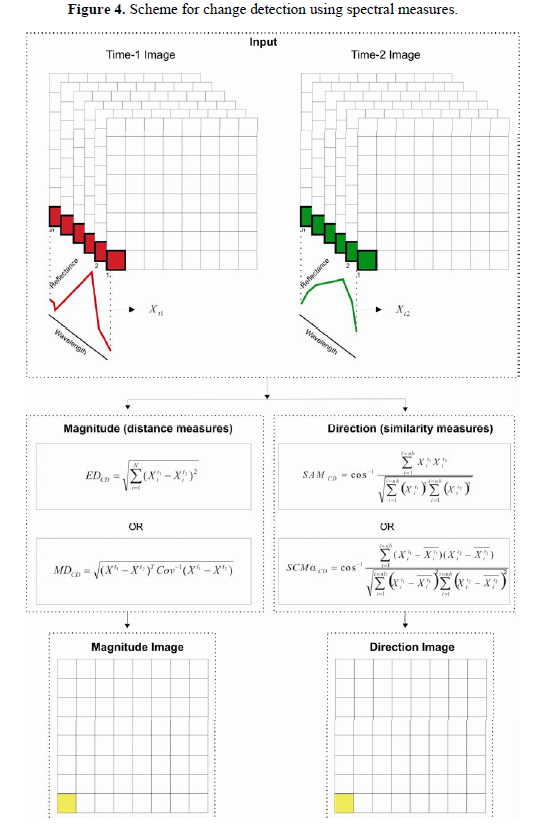Daily
Key Point
RBM
Siamese Network(一)(二)
Triplet Loss
Tensor 和 Matrix 区别
Radiant Correction(辐射校正)
Histogram Matching
Tracking
RPN
Fuzzy clustering
KL散度
Metric Learning(度量学习)
Idea
- 不断卷积但大小不变可能会导致特征信息在feature map中分布不均匀(过于集中在中间部分),并且,对于变化检测,如果进行深度卷积计算feature map之间的距离,是否会导致特征过于抽象,不足以表达pixel级别的变化信息?是否可以对不同feature map之间的距离进行加权,越深的权重越小?第一层是否要算?
- 异源图像变化检测,预训练的网络能否是一个“经过训练的输入是SAR图像,输出是Optical图像的模型”,相当于是“特征的提取与重建”。
- 变化检测的中“label unchanged”和“label changed”能否像GAN中分开训练,即一次大循环中,分别训练m次和n次。
- 异源图像变化检测中,pixel-wise计算Distance时,不仅计算两幅图之间的距离,还加上和自己图片的距离,二者进行加权,组成最后的距离。
[ ] 类似于 cGAN 的思想,只不过在计算 loss 的时候不仅加上 optical to SAR 的损失,还加上 SAR to optical 的损失,二者加权组成进行最后的 loss
Detail
CVA
Homogeneous v.s. Heterogeneous
Optical Image
光学图像通过测量可见光和近红外光的反射强度来成像。
- SAR Image
SAR图像中物体的外观由物体的几何形状和介电特性以及SAR传感器的发射/接收配置决定。
SAR图像(灰度)表示不同的物体,相对于光学图像噪声更多。
- 综合
无论是在SAR还是光学图像中,相同物体的颜色是一样的,即一幅图像中同种物体的
ROC & AUC
Unsupervised v.s. Supervised
- Unsuperivised
无监督一般通过全局信息或者一些算法,虽然可以达到无监督的目的,但是边界也会因此模糊。(卷积会提取特征,包括边界信息)
Metric
- Average ranking accross categories : (rank:Baseline + rank:Dynamic Background + rank:Camera Jitter + rank:Intermittent Object Motion + rank:Shadow + rank:Thermal) / 6
- Average ranking : (rank:Recall + rank:Spec + rank:FPR + rank:FNR + rank:PWC + rank:FMeasure + rank:Precision) / 7
- TP : True Positive
- FP : False Positive
- FN : False Negative
- TN : True Negative
- Re (Recall) : TP / (TP + FN)
- Sp (Specficity) : TN / (TN + FP)
- FPR (False Positive Rate) : FP / (FP + TN)
- FNR (False Negative Rate) : FN / (TP + FN)
- PWC (Percentage of Wrong Classifications) : 100 * (FN + FP) / (TP + FN + FP + TN)
- F-Measure : (2 Precision Recall) / (Precision + Recall)
- Precision : TP / (TP + FP)
- FPR-S : Average False positive rate in hard shadow areas
- CA : classification accuracy CA= (TP+TN)/(TP+TN+FP+FN)
- OE : overall error OE=FN+FP
Abbreviation
- CAE contractive autoencoder
- CCR correct classification rate
- CE change extraction
- CVA change vector analysis
- CVA compressed CVA
- DAE denoising autoencoder
- DBN deep belief networks
- DC direct comparison
- FCA feature change analysis
- FCM fuzzy C-means
- FLICM fuzzy local information C-means
- FN false negative
- FP false positive
- FSA feature similarity analysis
- GGKI generalized Gaussian model based on Kittler–Illingworth
- ICE Iterative conditional estimation
- ICM initial change map
- IF independent feature
- IR-MAD iteratively reweighed multivariate alteration detection
- JF joint feature
- KCCA kernel canonical correlation analysis
- MC mapping comparison
- MNN mapping neural network
- NGI neighborhood gray information
- NLP natural language processing
- OBCD object-based change detection
- OE overall errors
- PCA principal component analysis
- PCC post-classification comparison
- RFLICM reformulated FLICM
- SA
- SAE sparse autoencoder
- SAR synthetic aperture radar
- SDAE stacked denoising autoencoders
- SGD stochastic gradient descent
- SMC selective mapping comparison
- SRCNN super-resolution convolutional neural network
- TN true negative
- TP true positive
Paper
Feature Space Loss
Gram Array
Style Loss
风格迁移中利用 Gram 矩阵计算两幅图像之间的风格损失,。
- Gram 矩阵计算的是两两特征的相关性 , 即哪两个特征是同时出现的,哪两个特征是此消彼长的等,能够保留图像的风格
- ( 比如一幅画中有人和树,它们可以出现在任意位置,格拉姆矩阵可以衡量它们之间的关系,可以认为是这幅画的风格信息 )
将其直接应用于度量两个特征空间的距离是有一定问题的:


